
The original Ferris Wheel, sometimes also referred to as the Chicago Wheel, was designed and built by George Washington Gale Ferris Jr. as the centerpiece of the Midway at the 1893 World's Columbian Exposition in Chicago, Illinois. Since its construction, many other Ferris wheels have been constructed that were patterned after it.

Mary Livermore was an American journalist, abolitionist, and advocate of women's rights. Her printed volumes included: Thirty Years Too Late, first published in 1847 as a prize temperance tale, and republished in 1878; Pen Pictures; or, Sketches from Domestic Life; What Shall We Do with Our Daughters? Superfluous Women, and Other Lectures; and My Story of the War. A Woman's Narrative of Four Years' Personal Experience as Nurse in the Union Army, and in Relief Work at Home, in Hospitals, Camps and at the Front during the War of the Rebellion. She wrote a sketch of the sculptor Anne Whitney for Women of the Day and delivered the historical address for the Centennial Celebration of the First Settlement of the Northwestern States in Marietta, Ohio on July 15, 1788.
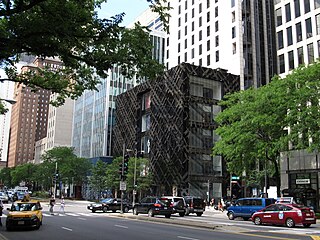
Michigan Avenue is a north-south street in Chicago that runs at 100 east on the Chicago grid. The northern end of the street is at Lake Shore Drive on the shore of Lake Michigan in the Gold Coast Historic District. The street's southern terminus is at Sibley Boulevard in the southern suburb of Dolton, but like many other Chicago streets, it exists in several disjointed segments.

Jackson Park is a 551.5-acre (223.2 ha) park located on the South Side of Chicago. The park was designed in 1871 by Frederick Law Olmsted and Calvert Vaux, then greatly remodeled in 1893 to serve as the site of the World's Columbian Exposition, making it one of the largest and most historically significant parks in the city.
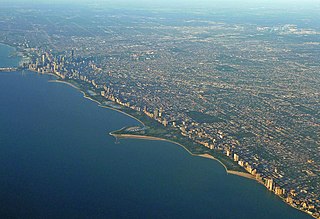
Lincoln Park is a 1,208-acre (489-hectare) park along Lake Michigan on the North Side of Chicago, Illinois. Named after US President Abraham Lincoln, it is the city's largest public park and stretches for seven miles (11 km) from Grand Avenue, on the south, to near Ardmore Avenue on the north, just north of the DuSable Lake Shore Drive terminus at Hollywood Avenue. Two museums and a zoo are located in the oldest part of the park between North Avenue and Diversey Parkway in the eponymous neighborhood. Further to the north, the park is characterized by parkland, beaches, recreational areas, nature reserves, and harbors. To the south, there is a more narrow strip of beaches east of Lake Shore Drive, almost to downtown. With 20 million visitors per year, Lincoln Park is the second-most-visited city park in the United States, behind Central Park.

Chicago History Museum is the museum of the Chicago Historical Society (CHS). The CHS was founded in 1856 to study and interpret Chicago's history. The museum has been located in Lincoln Park since the 1930s at 1601 North Clark Street at the intersection of North Avenue in the Old Town Triangle neighborhood. Long known as the CHS, the society adopted the name, Chicago History Museum, in September 2006 for its public presence.
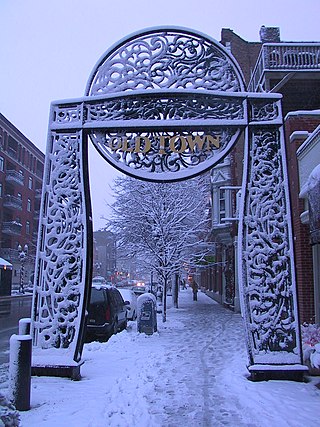
Old Town is a neighborhood and historic district in Near North Side and Lincoln Park, Chicago, Illinois, home to many of Chicago's older, Victorian-era buildings, including St. Michael's Church, one of seven buildings to survive the Great Chicago Fire.

The United States Sanitary Commission (USSC) was a private relief agency created by federal legislation on June 18, 1861, to support sick and wounded soldiers of the United States Army during the American Civil War. It operated across the North, raised an estimated $25 million in Civil War era revenue and in-kind contributions to support the cause, and enlisted thousands of volunteers. The president was Henry Whitney Bellows, and Frederick Law Olmsted acted as executive secretary. It was modeled on the British Sanitary Commission, set up during the Crimean War (1853-1856), and from the British parliamentary report published after the Indian Rebellion of 1857.

The Dexter Building was a landmark building located at 630 South Wabash Avenue, in the South Loop area of Chicago, Illinois. The building was designed by the firm of Dankmar Adler and Louis Sullivan, and built in 1887. Prior to its destruction in 2006 it was one of the earliest surviving Louis Sullivan buildings, and was considered a precursor of the nearby Auditorium Building. It was designated as a Chicago Landmark in 1996 and was described by the Landmarks Division of the City of Chicago Department of Planning and Development as an "irreplaceable link in the chain of work of one of the nation's most important architectural partnerships". It was distinctive in its use of exterior perforated girders, prefiguring designs of seven decades later.

St. Michael's Church in the Old Town neighborhood of Chicago is a Roman Catholic church staffed by the Redemptorist order of priests. The parish was founded to minister to German and Luxembourgish Catholic immigrants in 1852 with its first wooden church completed that year at a cost of $750. The building stands at the intersection of Eugenie Street and Cleveland Avenue. The church was built as a haven for German immigrants who were outcasts in Old Chicago. In addition, the town's main church, St. Joseph's Church, was overcrowded. The Redemptorists were invited to administer the parish in 1860 and a large brick church was finished in 1869. When completed, its tower made it the tallest building in Chicago and the United States, a distinction it held until the old Chicago Board of Trade Building was completed in 1885.
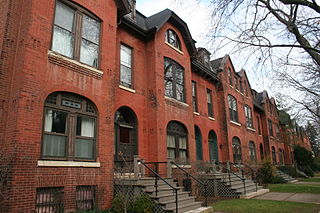
The McCormick Row House District is a group of houses located in the Lincoln Park community area in Chicago, Illinois, USA. It sits between East and West parts of DePaul University's Lincoln Park Campus and is independent from the school. They were built between 1884 and 1889 and used by the McCormick Theological Seminary to gain rental income. They were designed in the Queen Anne Style by the A. M. F. Colton and Son architects and joined the list of Chicago Landmarks May 4, 1971. The McCormick Row House District also lies within the boundaries of the Sheffield Historic District.
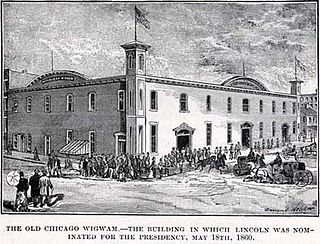
The Wigwam was a convention center and meeting hall that served as the site of the 1860 Republican National Convention. It was located in Chicago, Illinois, at Lake Street and Market near the Chicago River. This site had previously been the site of the Sauganash Hotel, Chicago's first hotel. This is where supporters ushered Abraham Lincoln to the party nomination and the eventual U.S. Presidency. The location at Lake and Wacker was designated a Chicago Landmark on November 6, 2002. The name "Wigwam" was later associated with host locations for both the 1864 Democratic National Convention and the 1892 Democratic National Convention in Chicago.

The Ukrainian Village District is a landmark-designated district of residential buildings within the West Town community area of Chicago, Illinois. It was designated a Chicago Landmark in 2002, with area extensions in 2005 and 2007.

The Wingert House is a nineteenth-century farmhouse located at 6231 North Canfield Avenue in Chicago, Illinois. One of the oldest surviving farmhouses within the Chicago city limits, the building received Chicago Landmark status on July 31, 1990. It is part of the Norwood Park neighborhood.

The Astor Street District is a historic district in Central Chicago, Illinois.

The Edward C. Waller Apartments are located from 2840 to 2858 W. Walnut Street in Chicago, Illinois. They were designed by Frank Lloyd Wright and built in 1895 and named after Edward C. Waller, a prominent Chicago developer after the 1871 fire. Waller and Wright collaborated on the Waller apartments and the Francisco Terrace apartments to execute Waller's pioneering idea of subsidizing lower income housing. Each apartment was designed with a parlor, chamber (bedroom), dining room, kitchen, bathroom, and closets.

Washington Block is a Chicago Landmark building located in the Loop community area of Chicago, Illinois, United States. Designed by Frederick and Edward Baumann, it was built between 1873 and 1874 in the aftermath of the Great Chicago Fire of 1871. It was designated a Chicago Landmark on January 14, 1997. When completed, Washington Block was one of the tallest buildings in the city of Chicago and is described as a rare example of the "isolated pier foundation" which contributed to the foundation of knowledge that has made Chicago the birthplace of the skyscraper. The building has limestone facades and originally included an exterior staircase that led to a second-floor corner entrance. The lobby has a curving hardwood staircase. Today the first floor is occupied by a 7-Eleven and the second floor occupied by Carter Legal Group PC. The building, which is located at the corner of North Wells Street and West Washington Street is five stories tall.

Illinois Centennial Memorial Column, Logan Square Monument or Illinois Centennial Monument is a public monument in the Logan Square community area and the Chicago Landmark and National Register of Historic Places-listed Logan Square Boulevards Historic District. Built in 1918 to celebrate the 100th anniversary of Illinois' statehood, the monument, designed by Henry Bacon, famed architect of the Lincoln Memorial in Washington, DC, is a single 70-foot (21 m) tall marble Doric column topped by an eagle, in reference to the Flag of Illinois. Reliefs surrounding the base depict figures of Native Americans, explorers, farmers and laborers intended to show the great changes experienced during the state's 1st century. Although Bacon designed the main column, Evelyn Beatrice Longman designed and sculpted the reliefs.

The Elks National Veterans Memorial is a Beaux Arts-style domed building at 2750 North Lakeview Avenue in Chicago, Illinois. It is across from Lincoln Park and close to the park's Goethe Monument and statue of Alexander Hamilton.

Sanitary fairs were fund-raising events held in various cities on behalf of the United States Sanitary Commission to raise funds and supplies for the Union Army during the American Civil War. Established in 1863, the last major event was held in 1865 in Chicago. From the outset of the USSC, many local groups sponsored fundraising events to benefit the Commission. As the civil war progressed, these became larger and more elaborate. Organizing these Sanitary Fairs offered ways for local communities to participate directly in supporting the war effort of the nation.




















